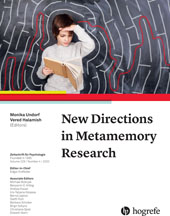The Language of Recollection in Support of Recognition Memory Decisions
Abstract
Abstract. Researchers often augment recognition memory decisions with confidence ratings or reports of “Remember” and “Know” experiences. While important, these ratings are subject to variation in interpretation and misspecification. Here we review recent findings from a “verbal reports as data” procedure in which subjects justify, in their own words, the basis of recognition. The application of a language pattern classifier to these justifications demonstrates that it: (a) is sensitive to the presence of recollection, (b) tracks individual differences in recognition accuracy, and (c) generalizes in a theoretically meaningful way to justifications from a separate experiment. More broadly, this approach should be useful for any cognitive decision task in which competing theories suggest different explicit bases underlying the judgments, or for which the explicit versus implicit basis of the decisions is in question.
References
(1959). Convergent and discriminant validation by the multitrait-multimethod matrix. Psychological Bulletin, 56, 81–105. https://doi.org/10.1037/h0046016
(2019). The language of accurate recognition memory. Cognition, 192, Article 103988. https://doi.org/10.1016/j.cognition.2019.05.025
(1980). Verbal reports as data. Psychological Review, 87(3), 215–251. https://doi.org/10.1037/0033-295X.87.3.215
(1993). Protocol analysis. Verbal reports as data (Revised ed.). MIT Press.
(1979). Metacognition and cognitive monitoring: A new area of cognitive–developmental inquiry. American Psychologist, 34(10), 906–911. https://doi.org/10.1037/0003-066X.34.10.906
(1998). Experiences of remembering, knowing, and guessing. Consciousness and Cognition, 7(1), 1–26. https://doi.org/10.1006/ccog.1997.0321
(2016).
Internal mapping and its impact on measures of absolute and relative metacognitive accuracy . In J. DunloskyS. K. TauberEds., The Oxford handbook of metamemory (pp. 39–61). Oxford University Press.(2017). Understanding metacognitive confidence: Insights from judgment-of-learning justifications. Journal of Memory and Language, 97, 187–207. https://doi.org/10.1016/j.jml.2017.08.002
(2019). Partitioning the sources of recognition confidence: The role of individual differences. Psychonomic Bulletin & Review, 26(4), 1317–1324. https://doi.org/10.3758/s13423-019-01586-w
(2004). Detection theory: A user’s guide, Taylor Francis.
(1980). Recognizing: The judgment of previous occurrence. Psychological Review, 87(3), 252–271. https://doi.org/10.1037/0033-295X.87.3.252
(2009). The influence of instructions and terminology on the accuracy of remember–know judgments. Consciousness and Cognition, 18(2), 401–413. https://doi.org/10.1016/j.concog.2009.02.010
(1993). Remembering and knowing: Two means of access to the personal past. Memory & Cognition, 21(1), 89–102. https://doi.org/10.3758/BF03211168
(2014). Relating the content and confidence of recognition judgments. Journal of Experimental Psychology: Learning, Memory, and Cognition, 40(1), 66–85. https://doi.org/10.1037/a0034059
(1996). Regression Shrinkage and Selection via the Lasso. Journal of the Royal Statistical Society: Series B (Methodological), 58(1), 267–288. https://doi.org/10.1111/j.2517-6161.1996.tb02080.x
(1985). Memory and consciousness. Canadian Psychology/Psychologie Canadienne, 26(1), 1–12. https://doi.org/10.1037/h0080017
(1994). Receiver-operating characteristics in recognition memory: Evidence for a dual-process model. Journal of Experimental Psychology: Learning, Memory, and Cognition, 20(6), 1341–1354. https://doi.org/10.1037/0278-7393.20.6.1341



